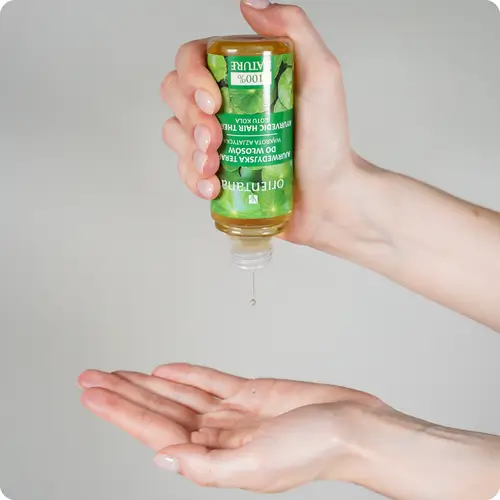Sesa oil is one of the most valued hair care products, dating back to traditional Ayurvedic medicine. It uses natural ingredients such as herbal oils, herbs and extracts that have been used for centuries in India to improve the condition of hair and scalp. Ayurveda creates many oils for the scalp and hair . In this article, we will discuss where Sesa oil comes from, its traditional uses in Ayurveda and the benefits of using it.

How was Sesa oil created?
SESA OIL AND ITS HISTORICAL ROOTS
Sesa oil comes from the tradition of Ayurveda, an ancient Indian system of medicine that dates back more than 5,000 years. Ayurveda views hair as a reflection of the overall health and balance of the body. Ancient Ayurvedic texts such as the Charaka Samhita describe herbs and oils that support hair growth, prevent hair loss, and delay the graying process.
Sesa oil has been developed based on these traditional recipes, combining natural ingredients into a harmonious formula. The product is based on knowledge passed down from generation to generation and is used in India for both hair care and health rituals.
SESA OIL - Ayurvedic tradition
Herbs and ingredients in the recipe
Sesa oil contains a rich composition based on Ayurvedic plants and herbs. Key ingredients include:
Bhringraj (Eclipta prostrata) : Known as the "king of hair", it supports hair growth, prevents hair loss and has anti-dandruff properties.
Amla (Emblica officinalis) : A source of vitamin C and antioxidants, it strengthens hair follicles and delays graying.
Neem (Azadirachta indica) : Has antibacterial and soothing properties, helping with scalp problems.
Shikakai (Acacia concinna) : A natural cleansing agent, it adds shine to the hair and improves its structure.
Sesame and Coconut Oil : Carrier oils that moisturize, nourish and strengthen hair.
Sesa oil is therefore a mixture of oils and plant extracts.

Sesa Oil Manufacturing Process
The traditional method of producing Sesa oil involves heating the ingredients in a base oil of sesame or coconut. This process extracts the active substances from the herbs, which are then combined into a harmonious blend. This technique is called Kshir Pak Vidhi in Ayurveda, which means "boiling in milk." This allows the oil to retain all its nutritional and therapeutic properties.
ORIENTANA SESA OIL - AYURVEDIC THERAPY

Orientana also produces its Sesa oil using Ayurvedic oils and herbs and manufactures it according to the principles of natural cosmetics and Ayurvedic guidelines.
It is an aromatic oil designed to be rubbed into the scalp and hair before washing. It strengthens, thickens, stimulates hair growth and reduces hair loss. It also has a nourishing effect on the scalp. The Hair Therapy formula contains 11 oils and 12 extracts from Indian herbs.
Using Sesa oil in hair care
Benefits of regular use
Regular use of Sesa oil brings a number of benefits to the condition of the hair and scalp. First of all, this oil strengthens the hair by intensively nourishing the hair follicles, which prevents their brittleness and excessive loss. The active ingredients contained in it, such as bhringraj and amla, support the regeneration of hair follicles, which stimulates the growth of new hair and improves its overall density.
Sesa oil also has strong moisturizing and regenerating properties. Thanks to its deep penetration into the hair structure, it helps smooth, soften and give it a healthy, shiny look. This effect is especially beneficial in the case of dry and damaged hair.
In addition, the presence of ingredients such as neem and shikakai helps to soothe scalp irritations. These natural substances reduce dandruff and itching, supporting the maintenance of healthy skin microflora. Regular use of Sesa oil can also delay the process of graying hair, which is possible thanks to the high content of antioxidants that neutralize free radicals and slow down the aging process.
In summary, Sesa oil is a versatile hair care product that not only strengthens hair and supports its growth, but also improves the condition of the scalp, contributing to the overall health and aesthetics of the hair.

How to use Sesa oil?
Using Sesa oil requires proper preparation and following a few steps that maximize its effectiveness. The first step is to prepare the hair by combing it thoroughly, which allows you to remove tangles and facilitates even distribution of the product.
Then, you should proceed to applying the oil. It is recommended to apply a small amount of the product directly to the scalp, and then gently massage for 5–10 minutes. Massage plays a key role because it improves microcirculation in the scalp, which increases the absorption of active ingredients contained in the oil. This process also promotes relaxation and improves the overall condition of the scalp.
After application, the oil should be left on the hair for several hours or overnight. Longer exposure time allows for deeper penetration of nutrients into the hair structure and hair follicles, which significantly increases the effectiveness of care.
The final step is to wash your hair thoroughly using a gentle shampoo, preferably sulfate-free. Shampoos with mild ingredients help maintain the natural moisture of your hair and scalp without damaging their protective barrier.
Following the described steps of using Sesa oil allows you to fully utilize its regenerative, strengthening and nourishing properties, ensuring optimal results in hair care.
Ayurveda and hair health
Ayurveda's Holistic Approach
Ayurveda treats hair care as part of a holistic approach to health. According to this philosophy, healthy hair is the result of balance in the body and the three doshas: vata , pitta and kapha . Sesa oil is designed to support this balance by working externally on the hair and scalp.
Ayurvedic Recommendations for Healthy Hair
Ayurveda, the traditional system of Indian medicine, offers a holistic approach to hair care, based on balancing the doshas (vata, pitta and kapha) and using natural methods and ingredients. In Ayurveda, healthy hair is considered a reflection of the overall health and balance of the body. Ayurvedic recommendations include both external hair care and internal support for health through diet, lifestyle and supplementation.
Balanced diet
Ayurveda emphasizes that hair health depends on proper nutrition of the body. A diet rich in nutrients that support hair growth and regeneration is recommended. A special role is assigned to:
- Proteins : Important for the formation of keratin, the main component of hair.
- Healthy fats : Vegetable oils, avocados and nuts support scalp hydration.
- Vitamins and minerals : Vitamins A, C, E, D, iron, zinc and biotin are crucial for keeping hair strong and shiny.
- Herbs and Spices : Ayurvedic herbs such as amla, bhringraj and shatavari support hair regeneration and prevent hair loss.
Proper hydration
Ayurveda recommends drinking enough water to keep both your body and scalp hydrated. Inadequate hydration can lead to dry skin, dandruff, and weak hair.
Scalp massage

Regular scalp massage with herbal oils such as sesame oil, coconut oil or bhringraj oil is a key element of Ayurvedic hair care. Massage:
- Improves blood circulation, which helps nourish hair follicles.
- It relaxes the nervous system, reducing stress, which is one of the main causes of hair loss.
- Supports hydration and strengthens hair structure.
Herbs and natural remedies
Ayurveda uses numerous herbs and natural ingredients in hair care:
- Amla : Rich in vitamin C, it strengthens hair and prevents greying.
- Bhringraj : Known as the “queen of hair”, it supports hair growth and prevents hair loss.
- Neem : It has antibacterial properties, soothes scalp irritations and reduces dandruff.
- Shikakai : A natural cleansing agent, it gently cleanses the hair while moisturizing it.
Avoiding harmful factors
Ayurveda emphasizes avoiding practices and factors that can weaken hair:
- Excessive use of chemical styling and dyeing products.
- Sun exposure without hair protection.
- Frequent use of heat styling devices such as straighteners or blow dryers.
- Bad habits, such as combing or tying hair too tightly.
Stress management
Stress is a major factor in hair problems such as hair loss and premature greying. Ayurveda recommends relaxation techniques such as meditation, yoga and pranayama (breathing techniques) to minimize the impact of stress on hair health.
Sleep and regeneration
Adequate sleep is essential for the body's regenerative processes, including hair health. Ayurveda recommends a regular circadian rhythm, avoiding late bedtimes, and creating a relaxing environment conducive to rest.
Regular cleansing of the body
According to Ayurveda, the accumulation of toxins (ama) in the body can negatively affect the health of hair. Regular cleansing practices such as drinking lemon water, using herbs that aid in detoxification (e.g. triphala), and avoiding heavy meals are key to maintaining healthy hair.
Summary
Sesa oil is a unique product that combines the tradition of Ayurveda with modern hair care needs. Thanks to a rich blend of natural ingredients such as bhringraj, amla and neem, and a unique manufacturing process, this oil offers effective hair regeneration, strengthening and hydration. Regular use of Sesa oil, combined with a holistic approach to health, can bring long-term benefits, not only for hair, but also for general well-being. Choosing Sesa oil is a return to natural care methods that have proven themselves over the centuries.






